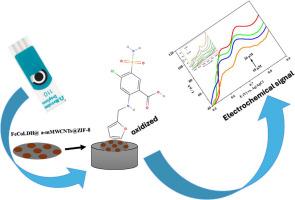Fe-Co LDH@ZIF-8磁性mwcnts修饰的SPCE电化学和高效液相色谱检测速尿
IF 5.6
3区 材料科学
Q1 ELECTROCHEMISTRY
引用次数: 0
摘要
本研究展示了电化学和高效液相色谱技术在血液和唾液样品中呋塞米(FSD)鉴定中的应用。将一种由钴铁层状双氢氧化物(LDH)、ZIF和磁性多壁碳纳米管(mMWCNTs)组成的纳米复合材料整合到丝网印刷碳电极(SPCE)上。利用FTIR、XRD、FESEM等表征了纳米复合材料的形成和结构。循环伏安法(CV)表明,由于改性剂的协同作用,修饰电极(Fe-Co LDH@ZIF-8@mMWCNT/SPCE)比未修饰的SPCE具有显著增强的峰值电流响应性和更好的电子转移。该传感器能够检测3.0 μM的极低浓度的物质,比同类电化学传感器的检测范围低2-5倍,通常为6-15 μM。该传感器使用相对简单的纳米复合材料组件提供强大的性能,为实际样品分析提供实用性,灵敏度为4.04µA·µM⁻¹。仿造生物样品的回收率为90.6% ~ 94.6%,结果准确可靠。研究结果表明,所提出的纳米修饰技术解决了传统基于spce的传感器的灵敏度挑战,使临床样品中的FSD检测成为可能。本文章由计算机程序翻译,如有差异,请以英文原文为准。


Electrochemical and HPLC-based detection of furosemide using Fe-Co LDH@ZIF-8 magnetic MWCNT-modified SPCE
This study demonstrates the application of both electrochemical and HPLC techniques for the identification of furosemide (FSD) in blood and saliva specimens. A nanocomposite comprising cobalt–iron layered double hydroxide (LDH), ZIF, and magnetic multiwalled carbon nanotubes (mMWCNTs) was incorporated onto a screen-printed carbon electrode (SPCE). FTIR, XRD, and FESEM were employed to elucidate the formation and structure of the nanocomposite. Cyclic voltammetry (CV) revealed that the modified electrode (Fe–Co LDH@ZIF-8@mMWCNT/SPCE) exhibited significantly enhanced peak current responsiveness and superior electron transfer compared to the unmodified SPCE owing to the synergistic effect of the modifiers. The suggested sensor is capable of detecting FSD at exceptionally low concentrations of 3.0 μM, which is 2–5 times lower than the detection range of comparable electrochemical sensors, typically ranging from 6–15 μM. This sensor delivers robust performance using comparatively straightforward nanocomposite assembly, offering practicality for real-sample analysis with sensitivity of 4.04 µA·µM⁻¹. The recovery rates for counterfeit biological samples ranged from 90.6 % to 94.6 %, indicating that the results are accurate and reliable. The findings indicate that the proposed nano-modification technology addresses the sensitivity challenges associated with conventional SPCE-based sensors, enabling the detection of FSD in clinical samples.
求助全文
通过发布文献求助,成功后即可免费获取论文全文。
去求助
来源期刊

Electrochimica Acta
工程技术-电化学
CiteScore
11.30
自引率
6.10%
发文量
1634
审稿时长
41 days
期刊介绍:
Electrochimica Acta is an international journal. It is intended for the publication of both original work and reviews in the field of electrochemistry. Electrochemistry should be interpreted to mean any of the research fields covered by the Divisions of the International Society of Electrochemistry listed below, as well as emerging scientific domains covered by ISE New Topics Committee.
 求助内容:
求助内容: 应助结果提醒方式:
应助结果提醒方式:


